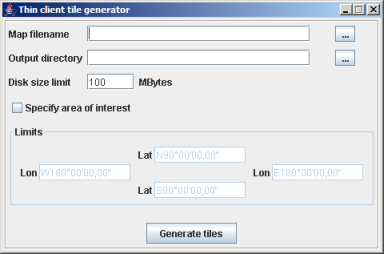Perforce JViews Maps Sample: Generating Server Tiled Maps
Description
 |
This demonstration is a simple GUI tool to generate a pyramid of tile images from a JViews map file.
How to Use the Sample
- Launch the tile generator.
-
Choose an
.ivlmap file that needs to be tiled. Note that this file must contain thin client tiling parameters. The parameters can be set in the Map Builder using Thin Client Settings command in the Options menu. Refer to Using the Map Builder for further information. - Choose an output folder.
- Choose a maximum disk size (a map with multiple predefined scales can produce hundreds of megabytes).
- Click the "generate tiles" button.
How to Run the Sample as an Application
This sample can
be run as an application.
The installation directory contains
an executable JAR file,
tilegeneration.jar,
that allows you to execute the sample with a double click from a
file browser. Note that if you are using Internet Explorer, you can
open the installation directory
and execute the JAR file from the browser. This
technique may not work in other Web browsers.
Alternatively, you
can run the sample application from the command line.
First check that the Ant utility is properly configured. If not, see the
instructions on how to configure Ant for Perforce JViews.
Then, go to the installation directory
of the sample and type:
ant run
Topics Covered
- JavaServer Faces Maps
- Thin client
Detailed Description
This demonstration is a simple GUI tool to generate a pyramid of tile images from a JViews map file. These images can be used to fill the cache of a maps servlet to improve loading times on the client side.
Installation Directory
The Generating Server Tiled Maps sample is installed here.